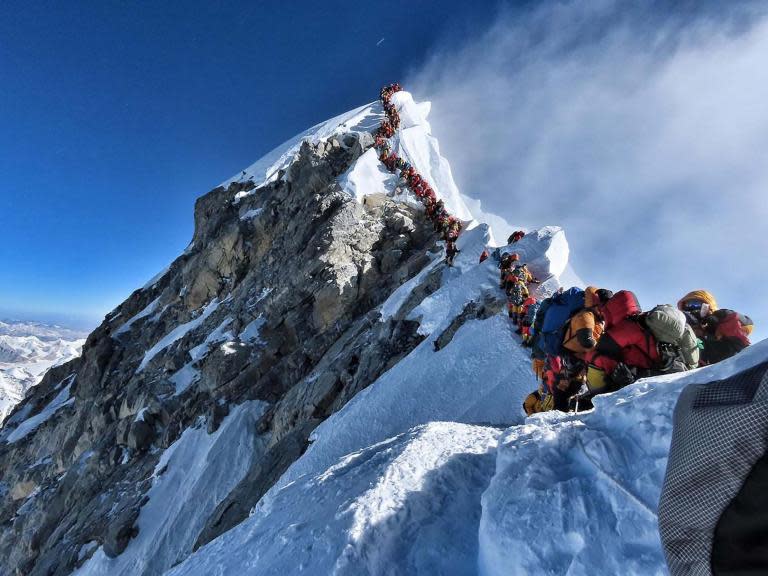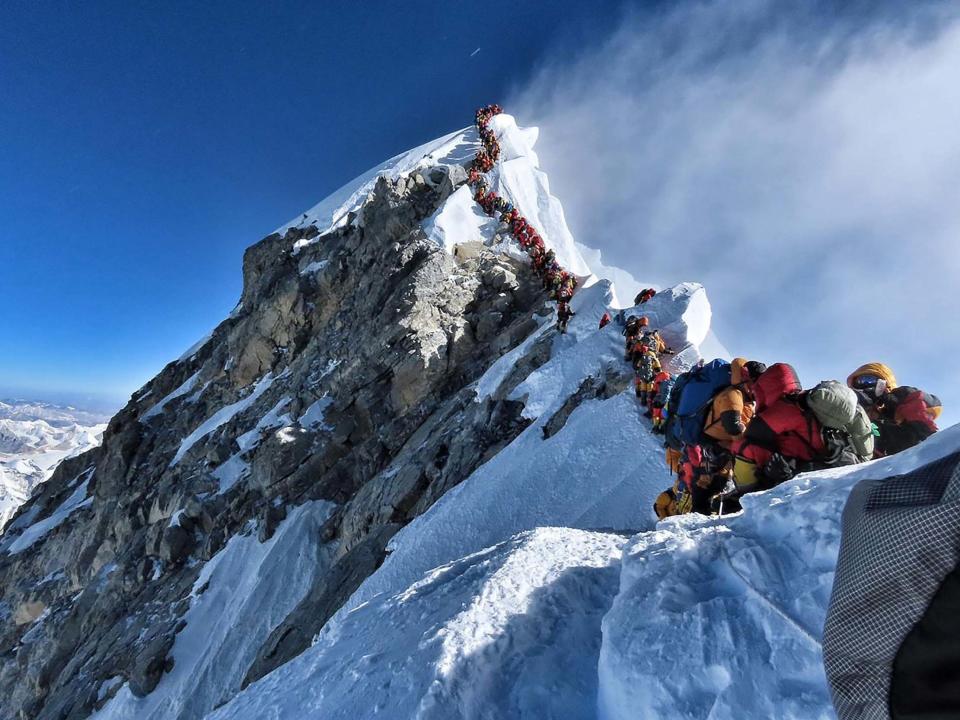1 / 2
Everest climbers forced to clamber over corpses as mountain mired in 'chaos' on anniversary of first successful ascent
Sixty-six years to the day since Tenzing Norgay and Edmund Hillary became the first people to scale Mount Everest, numerous climbers have spoken out about the lethal impact of overcrowding and underpreparedness on the summit of the world’s tallest mountain.Since Nepal opened its side of the mountain to commercial climbing a half-century ago, the allure of Everest has grown, and so too have the crowds and the deaths, to the extent that this year climbers have spoken of “walking over bodies” to reach the peak.On May 22 a climber took a photograph showing an enormous queue of climbers standing crampon-to-crampon, clipped on to the safety line to reach the summit.Other climbers spoke of stepping round dead climbers who were still attached to the safety rope on the final ascent.One British man who died minutes after reaching the summit on Saturday had spoken of his concern about overcrowding on the peak.Elia Saikaly, a Canadian film-maker who was filming four Arab women on the mountain on Thursday, wrote on Instagram: “I cannot believe what I saw up there. Death. Carnage. Chaos. Lineups. Dead bodies on the route and in tents at camp 4. “People who I tried to turn back who ended up dying. People being dragged down. Walking over bodies. Everything you read in the sensational headlines all played out on our summit night.”This year around 600 people are believed to have summited the mountain, and the number of deaths, which included 11 in just nine days, is the highest since 2015, when severe avalanches caused several deaths.Nepal is one of the world's poorest countries and relies on the climbing industry to bring in $300m (£237m) a year.The climbing season on the mountain is only a few weeks long, and the weather dictates when the summit is scalable and also contributes to overcrowding.This season saw a record number of 381 climbing permits issued to foreign climbers by the Nepalese government. This is only nine more than the number issued in 2018, and each costs $11,000 (£8,700).No experience requirements are made by the Nepalese government for the issuing of permits, and the government has denied its permit process has contributed to the numbers of deaths."There were more people on Everest than there should be," the Kul Bahadur Gurung, the general secretary of the Nepal Mountaineering Association, an umbrella group of all expedition operators in Nepal. He told the Associated Press: "We lack the rules and regulations that say how many people can actually go up and when." Most of those who died are believed to have suffered from altitude sickness, which is caused by low amounts of oxygen at high elevation and can cause headaches, vomiting, shortness of breath and mental confusion. Once only accessible to well-heeled elite mountaineers, Nepal's booming climbing market has driven down the cost of an expedition, opening Everest up to hobbyists and adventure-seekers.Nepal requires climbers to have a doctors' note deeming them physically fit, but not to prove their stamina at such extreme heights. Because of the altitude, climbers have just hours to reach the top before they are at risk of a pulmonary edema, when the lungs fill with liquid. From Camp Four at 8,000 metres (26,240 feet) to the 8,850-metre (29,035-foot) peak, the final push on Everest is known as the "death zone." The conditions are so exhausting at such times that when a person dies, no one can afford to expend energy on carrying the body down from the mountain. "Every minute counts there," said Eric Murphy, a mountain guide from Bellingham, Washington, who climbed Everest for a third time on May 23. He said what should have taken 12 hours took 17 hours because of struggling climbers who were clearly exhausted but had no one to guide or help them. Just a handful of inexperienced climbers, he said, is "enough to have a profound effect". The deaths this year on Nepal's side of the mountain included Don Cash, a sales executive from Utah, and Christopher Kulish, an attorney from Colorado, who both died on their way down from the peak. Kulish, 62, had just reached the top with a small group after crowds of climbers congested the peak last week, according to his brother, Mark Kulish. He described his brother as an attorney who was an "inveterate climber of peaks in Colorado, the West and the world over." Just before he died, Kulish made it into the so-called "Seven Summit Club" of mountaineers who have reached the highest peaks on every continent, his brother said. Mr Cash, 55, collapsed at the summit and was given CPR and massages by his two Sherpa guides. He got up only to fall again in the same way at Hillary Step, the first cliff face down from the summit. His body was left near there. Irish professor Seamus Lawless, aged 39 and from County Wicklow, fell during his descent from the peak having achieved a lifetime ambition of reaching the summit. The search for Mr Lawless, presumed dead, has been called off.Another Irish man, Kevin Hynes, 56, died in his tent at 7,000m after turning back before reaching the summit. The father of two was part of a group from UK-based climbing company 360 Expeditions.An Austrian climber and two Indian climbers are also reported to have died in the past week. Earlier this year climbers reported growing numbers of bodies emerging from melting glaciers on Everest.In addition to the physical impracticality of climbers removing bodies from the mountain, it is also dangerous and very expensive, so the vast majority of those who have died while trying to reach the summit remain on the mountain.More than 300 people are thought to have died on Everest over the last 50 years and around two-thirds of the corpses are currently believed to be buried beneath ice and snow.Additional reporting by AP
Three climbers and a guide have died on Mount Everest, taking to eight the number killed in a week as record numbers tackling the world’s highest mountain have caused dangerous crowding.
More than 120 climbers scaled Everest on Thursday, but some were caught in the crowd of people on the slopes, leading to exhaustion, dehydration and death, Nepalese officials said.
The death toll so far this season outstrips the five killed in the whole of last year.
“Traffic jams” of climbers have formed near the summit this year after about 380 permits to climb were issued. Last year Nepal issued 365 permits for expeditions to Mount Everest; in 2016 it was 289.
Two women and a man from India died of exhaustion while descending from the 8,850 metre (29,035 feet) peak.
They were Anjali Sharad Kulkarni, 54, Kalpana Das, 49, and Nihal Ashpak Bagwan, 27.
A tour organiser said Bagwan had been “stuck in the traffic for more than 12 hours and was exhausted”.
Others who were killed this week included a 65-year-old Austrian climber, who died on the northern Tibet side, another Indian and an American.
A member of a Swiss team died high up on the Tibetan side on Thursday, according to Everest blogger Alan Arnette, who cited a Swiss operator, Kobler & Partner. The climber’s name has not been released.
An Irish professor, Seamus Lawless, has not been seen since falling on 16 May.
A total of 17 climbers have died or are missing on different Himalayan peaks in Nepal, seven of them Indians, since the start of the climbing season in March.
“The winds have returned, plus the routes are extremely crowded on both sides, due to few summit weather windows this spring,” Mr Arnette said on his blog.
The American who died, Don Cash, 55, had fulfilled his dream of climbing the highest mountain on each continent when he conquered Everest.
“When he was on the top he just fell. The two sherpas who were with him gave CPR and massages. After that he woke up, then near Hillary Step he fell down again in the same manner, which means he got high altitude sickness,” said Pasang Tenje Sherpa, head of Pioneer Adventure, which provided the guides.
Altitude sickness, caused by low oxygen at height, causes headaches, vomiting, shortness of breath and mental confusion.
Agencies contributed to this report

 Yahoo News
Yahoo News 

